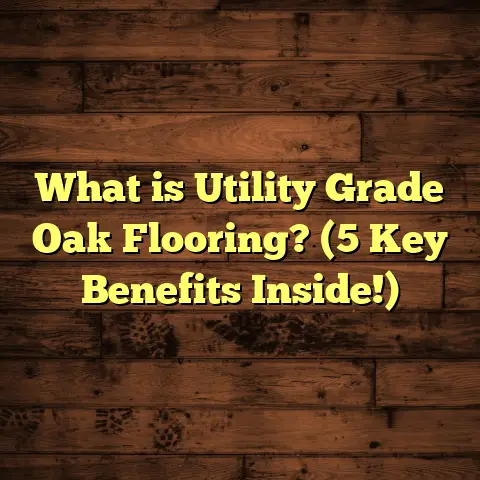What is Floor Inspection? (5 Key Benefits for Safety & Value)
What is Floor Inspection?
Have you ever stopped to think about what really goes into a floor inspection? I ask that because it’s something I’ve been involved with for years in my work as a flooring contractor. It’s a part of the job that often gets overlooked by homeowners and even some professionals. But it’s absolutely key to keeping floors safe, durable, and beautiful.
So, what is floor inspection exactly? Simply put, it’s a detailed evaluation of your floor’s condition — looking beyond just the surface to check for structural soundness, damage, moisture problems, installation issues, and potential safety hazards. It’s about understanding how your floor is holding up and what needs to be done to maintain or improve it.
This isn’t just a quick look-around. A proper floor inspection can include testing moisture levels, checking for subfloor damage, identifying wear patterns, and noting any defects like cracks or loose boards. The goal? To catch problems early before they turn into expensive repairs or safety risks.
Over the years, I’ve inspected all kinds of floors — hardwoods, laminates, vinyl, tile, carpeted surfaces — each with its own quirks and challenges. And I can tell you, every inspection tells a story about the history of that floor and what it’s been through.
Why Floor Inspection is Becoming More Important Today
You might wonder why more people are paying attention to floor inspections now than before. One big reason is that flooring materials and installation techniques have evolved a lot in recent years. There’s a wider variety of options than ever — from engineered hardwood to luxury vinyl planks — and each requires different care.
Also, homes and buildings are being designed with tighter envelopes for energy efficiency. This can sometimes trap moisture inside walls and floors if ventilation isn’t right. Moisture problems hidden beneath flooring layers are becoming more common and can cause mold or rot that’s not visible on the surface.
And then there’s safety. As populations age worldwide, preventing falls at home or in public spaces has become a huge concern. Floors that are uneven, slippery, or damaged contribute significantly to accidents—especially for seniors or children.
With these trends happening, floor inspections have taken on new urgency as part of routine maintenance and safety checks. It’s no longer just about looks — it’s about performance, health, and value.
What Happens During a Floor Inspection?
Let me walk you through what I do when inspecting a floor. The process usually starts with a visual walk-through. I look carefully at the surface condition — scratches, stains, discoloration, cracks, tiles missing grout or loosened.
But I don’t stop there. For wood floors, I test moisture levels using a moisture meter because excess humidity can cause warping or cupping. If it’s tile or stone flooring, I check grout integrity and look for any signs of movement or cracks in the substrate.
Sometimes I have to lift a corner of carpet or vinyl to inspect underneath for mold or damage. This is crucial because problems hidden below can worsen quickly if left unchecked.
For commercial jobs especially, I also assess wear patterns and slip resistance. High-traffic areas often show signs of stress sooner than residential floors.
Finally, I document everything with photos and notes before preparing a detailed report recommending repairs or maintenance steps.
Common Challenges I Encounter During Floor Inspections
Not all inspections go smoothly. Sometimes I find issues that make me wish the floor had been checked sooner.
One frequent challenge is hidden water damage. For example, in older homes with hardwood floors installed over concrete slabs without vapor barriers, moisture wicks up causing rot. The owners often don’t notice until boards start lifting or mold odor develops.
Another tricky area is floors with multiple layers—like vinyl over wood or carpet over tile. When moisture gets trapped between layers, it’s tough to spot without lifting materials carefully.
Poor installation is another headache I see too often: uneven subfloors leading to squeaks or tiles popping loose; nails sticking up under hardwood planks; improper adhesive use causing delamination of vinyl sheets.
Sometimes clients hope their floors are fine but the inspection reveals structural weaknesses in subfloors or joists that need urgent attention.
Success Stories from Floor Inspections
On the brighter side, I’ve had many moments where thorough inspections prevented disasters and saved clients money.
One case involved a family moving into a newly purchased home with what looked like perfect hardwood floors. After my inspection, we discovered termites had damaged joists underneath severely enough to threaten the floor’s stability. Early detection meant pest control could be applied immediately and repairs made before any accidents happened.
Another time I helped a restaurant owner avoid costly liability by identifying slippery tile patches in the kitchen due to grease buildup hidden under mats. We recommended replacing those tiles with slip-resistant alternatives.
I also remember inspecting floors in a hospital where strict hygiene standards meant catching mold growth under carpets was critical to patient safety.
These experiences show that inspections aren’t just about fixing floors — they protect people’s health and safety too.
Five Key Benefits of Floor Inspection for Safety & Value
1. Prevent Injuries by Identifying Safety Hazards
Safety is at the top of my list whenever I inspect floors. Loose boards, uneven tiles, protruding nails — these might seem like small issues but can cause trips and falls.
Did you know falls are one of the leading causes of injury in homes? According to the Centers for Disease Control and Prevention (CDC), approximately 36 million people fall each year in the U.S., resulting in over 8 million emergency visits. Flooring-related hazards contribute significantly to these numbers.
I once inspected a daycare center where sections of carpet were frayed and uneven. Fixing those made the environment safer for kids running around.
By catching potential hazards early through inspection, you’re protecting your family, employees, or customers from unnecessary accidents.
2. Save Money by Avoiding Major Repairs
Ignoring minor flooring problems can lead to expensive fixes down the road. For example, that small crack in your tile might grow into a full replacement job if water seeps underneath causing the subfloor to rot.
In my years working in residential flooring, I’ve seen how early detection through inspection slashed repair costs by up to 50% for clients compared to waiting until damage worsened.
National Flooring Contractors Association data suggests that regular inspections combined with preventive maintenance can extend flooring lifespan by 20-30%.
So investing in an inspection today can keep your budget intact tomorrow.
3. Increase Property Value with Well-Maintained Floors
Whether selling your home or leasing a commercial space, flooring condition influences buyer impressions and value perception.
A recent study by Zillow showed homes with updated flooring sold 7% faster than those with outdated or damaged floors.
During real estate walkthroughs I’ve done as part of inspection services, buyers often ask questions about floor quality upfront if they see damage or wear signs. A clean inspection report reassures them and supports asking prices.
4. Improve Indoor Air Quality by Detecting Mold & Moisture
Floors aren’t just about aesthetics; they impact indoor air quality too. Mold growth under carpets or vinyl caused by trapped moisture is a common problem that worsens allergies and respiratory issues.
The Environmental Protection Agency (EPA) warns that damp indoor environments encourage mold growth which releases spores harmful to health.
During inspections, measuring moisture content and checking for mold signs helps prevent long-term health consequences for occupants.
5. Gain Peace of Mind with Clear Knowledge of Floor Condition
Finally, many clients tell me how much relief they feel after getting an honest floor condition report instead of guessing if there are hidden problems.
Knowing exactly what you’re dealing with helps you plan maintenance schedules or renovations without surprises cropping up unexpectedly.
I often hear stories about people who found out too late about major damage that could have been prevented if only inspected earlier — don’t be one of them!
Diving Deeper: Types of Flooring Inspections Based on Material
Each flooring type has unique inspection requirements based on how it wears and what problems typically arise:
Hardwood Floors
Wood floors require checks for moisture content (ideal range is 6-9%), signs of warping or cupping from water exposure, loose nails/screws causing squeaks, surface scratches or gouges, and subfloor integrity.
I use pinless moisture meters frequently here because pin meters can damage delicate finishes.
Laminate Flooring
Laminate doesn’t handle water well so inspecting seams for gaps where moisture can enter is critical. Also watching for swelling or buckling boards that indicate moisture intrusion beneath.
Since laminate rests on underlayment above subfloor, checking both layers matters during inspection.
Vinyl Floors
With vinyl floors (sheet or plank), I inspect adhesive integrity to prevent peeling or curling edges. Moisture testing under vinyl sheets is important as trapped water can cause mold growth unnoticed on top.
Tile and Stone Floors
Tile inspections focus on grout condition (cracking or missing grout invites water penetration), cracked or loose tiles that pose trip hazards, and substrate issues like cracking concrete beneath tiles.
Slip resistance also matters—especially in wet areas like bathrooms or commercial kitchens where falls happen frequently.
Carpeted Floors
Carpets hide many problems underneath such as mold growth from spills or humidity buildup, padding deterioration affecting comfort and support, and tack strip conditions securing carpet edges safely.
My Personal Approach: How I Perform Detailed Floor Inspections
When I arrive at a site for inspection, here are the steps I take:
- Initial Walkthrough: Visual scan noting obvious damage or wear.
- Ask Questions: I speak with owners about any known issues like previous leaks or repairs.
- Moisture Testing: Using appropriate tools based on material.
- Structural Check: Tapping boards/tiles to detect hollow sounds indicating voids.
- Safety Assessment: Identify trip/slip hazards.
- Documenting: Photos & detailed notes.
- Reporting: Clear explanation of findings plus prioritized recommendations—whether immediate fixes or maintenance tips.
I customize this process depending on client needs—for example offering follow-up consultations on repair options if requested.
Case Study: Saving $12,000 Through Early Floor Inspection
Here’s one case that sticks out:
A young couple bought a charming older home with beautiful oak floors covered by rugs. They planned to refinish but called me first for an inspection. Using moisture meters under rugs revealed elevated humidity near an exterior wall—tracing back to poor drainage outside causing seepage beneath the slab foundation.
Because we caught this early before sanding began:
- They repaired exterior drainage issues.
- Replaced damaged subfloor sections.
- Applied vapor barriers before refinishing.
The total cost was $3,000 instead of $15,000+ had they waited until floors buckled badly requiring full replacement plus foundation repairs later on.
What You Can Do Between Inspections: Maintenance Tips
While professional inspections are invaluable, there are simple things you can do regularly at home:
- Keep humidity levels between 30%-50% using dehumidifiers.
- Clean spills immediately especially on wood & laminate.
- Use rugs in high-traffic areas but lift regularly to check for mold underneath.
- Avoid harsh chemicals damaging finishes.
- Tighten loose nails/screws on hardwood occasionally.
- Replace worn grout on tile floors promptly.
These steps reduce wear and keep your floors healthier longer between inspections.
How Often Should You Get Your Floors Inspected?
Good question! It depends on usage and environment but here’s my general rule:
- Residential: Every 2-3 years for wood & laminate; every 1-2 years for high-moisture areas like bathrooms/kitchens.
- Commercial: Annual inspections recommended due to heavy foot traffic.
- After Water Events: Always inspect after flooding or leaks regardless of schedule.
If you’re buying/selling property or planning renovations—get an inspection beforehand for peace of mind.
Advanced Tools & Technology in Floor Inspections
Technology is helping make floor inspections more precise:
- Infrared Cameras: Detect temperature differences indicating moisture behind walls/floors.
- Digital Moisture Meters: Provide accurate readings without damaging surfaces.
- 3D Scanners: Map subfloor conditions in commercial buildings.
- Smart Sensors: Installed permanently to monitor humidity & structural movement over time remotely.
I’ve started using some of these tools in my work — they add another layer of certainty especially in tricky cases like hidden leaks or older buildings with complex flooring systems.
Real Talk: Common Myths About Floor Inspection Debunked
There are plenty of misconceptions floating around:
- “My floors look fine so no need to inspect.”
Even flawless-looking surfaces can hide problems beneath that worsen over time without warning. - “Floor inspections are expensive.”
Actually they’re affordable compared to repair bills from missed issues—think of it as insurance for your investment! - “Only old homes need inspections.”
New builds can also suffer from installation errors or environmental factors causing damage early on—inspections catch these too.
Knowing these myths helps you avoid costly mistakes down the line!
Summary So Far: Why Floor Inspection Matters
To recap:
- Floors affect safety, health, aesthetics, and property value.
- Inspections reveal hidden damage & prevent accidents.
- Early detection saves money on repairs & replacements.
- Properly maintained floors last longer & look great.
- Regular inspections provide peace of mind.
If you care about your home or business space—and who doesn’t?—floor inspections deserve a spot on your maintenance checklist.
How You Can Prepare for a Floor Inspection
Ready to get started? Here are some tips:
- Clear furniture from rooms being inspected so everything is visible.
- Share any known history about leaks/damages with your inspector upfront.
- Take notes during inspection walk-through if possible.
- Ask questions about findings and recommended fixes.
Being involved helps you understand what’s going on with your floors and make smarter decisions afterward.
When Should You Call a Professional?
Some minor issues you might handle yourself but many problems require expert attention:
- Persistent moisture problems detected during inspections.
- Structural damages like sagging subfloors or loose joists.
- Extensive mold or pest damage under flooring.
- Complex installation corrections (e.g., leveling subfloors).
Don’t hesitate to call pros early; delaying only makes things worse (and more expensive).
My Final Thoughts on Floor Inspections
Over my career working hands-on with countless floors and clients,
I can say confidently that skipping an inspection is a risk not worth taking.
Floors carry us every day — literally support our lives — yet they get overlooked until something breaks down. Taking time to inspect them regularly keeps your space safer, healthier, and looking its best longer.
If you want honest advice tailored specifically to your flooring type and needs—or help interpreting an inspection report—I’m happy to chat anytime!
Got questions? Fire away!
Would you like me to add anything else? Maybe specific checklists per flooring type? Or more case studies?





